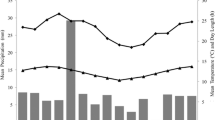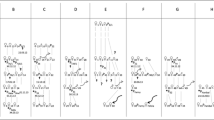Abstract
Greater dwarf lemurs (Cheirogaleus major) are small nocturnal primates from the rain forests of eastern Madagascar. I investigated a population of Cheirogaleus major in a littoral rain forest of Southeast Madagascar during 2 rainy seasons to supplement the sparse information available for the species. I collected data on morphology, group composition, sleeping behavior, home range, and social organization via mark/recapture, radio telemetry, and focal individual observations. I identified 2 presumed family groups, and my data from radiotracking revealed a monogamous social organization. In each group, I found an adult pair and its presumed offspring sharing home ranges and sleeping sites together. I also observed gregarious behavior of group members during their nocturnal activity. I found no difference in body measurements between sexes, but body mass and tail circumference increased significantly from November to February, indicating a fatting period before hibernating.


Similar content being viewed by others
References
Bearder, S. K. (1987). Lorises, bushbabies, and tarsiers: Diverse societies in solitary foragers. In B. B., Smuts, D., Cheney, R. M., Seyfarth, R. W., Wrangham, & T. T., Struhsaker (eds.), Primates Societies (pp. 11–24). Chicago: University of Chicago Press.
Charles-Dominique, P. (1977). Ecology and Behavior of Nocturnal Primates. New York: Columbia Press University Press.
Clark, A. (1985). Sociality in a nocturnal solitary prosimian: Galago crassicaudatus. International Journal of Primatology, 6, 581–600.
Creigthon, G. K. (1990). Madagascar Minerals Project. Environmental Impact Assessment. Appendix IV. Terrestrial Vertebrate Fauna Study. Lewis Environmental Consultants, Montreal.
Fietz, J. (1999). Monogamy as a rule rather than exception in nocturnal lemurs: The case of the fat-tailed dwarf lemur, Cheirogaleus medius. Ethology, 105, 259–272.
Fietz, J., & Ganzhorn, J. U. (1999). Feeding ecology of the hibernating primate Cheirogaleus medius: How does it get so fat? Oecologia, 121, 157–164.
Foerg, R. (1982). Reproduction in Cheirogaleus medius. Folia Primatologica, 39, 49–62.
Ganzhorn, J. U. (1988). Food partitioning among malagasy primates. Oecologia, 75, 436–450.
Ganzhorn, J. U. (1989). Niche separation of seven lemur species in the eastern rainforest of Madagascar. Oecologia, 79, 279–286.
Goodman, S. M. (2003). Mammals: Predation on lemurs. In S. M., Goodman, & J. P., Benstead (eds.), The Natural History of Madagascar (pp. 1221–1228). Chicago: University of Chicago Press.
Gursky, S. (2002a). The behavioral ecology of the spectral tarsier, Tarsius spectrum. Evolutionary Anthropology, 11, 226–234.
Gursky, S. (2002b). Determinants of gregariousness in the spectral tarsier (Prosiman: Tarsius spectrum). Journal of Zoology, 256, 401–410.
Gursky, S. (2005). Associations between adult spectral tarsiers. American Journal of Physical Anthropology, 128, 74–83.
Hapke, A., Fietz, J., Nash, S. D., Rakotondravony, D., Rakotosamimanana, B., Ramanamanjato, J.-B., et al. (2005). Biogeography of dwarf lemurs: Genetic evidence for unexpected patterns in southeastern Madagascar. International Journal of Primatology, 26, 873–901.
Harcourt, C., & Thornback, J. (1990). Lemurs of Madagascar and the Comoros. The IUCN Red Data Book, Gland, Switzerland and Cambridge.
Isbell, L. (1994). Predation on primates: Ecological patterns and evolutionary consequences. Evolutionary Anthropology, 3, 61–71.
Janson, C. (1992). Evolutionary ecology of primate social structure. In E. Alden-Smith, & B. Winterhalder (eds.), Evolutionary Ecology and Human Behavior (pp. 95–130). New York: Aldine.
Kappeler, P. (1997). Determinants of primate social organization: Comparative evidence and new insights from Malagasy lemurs. Biological Reviews, 72, 111–151.
Krebs, J. R., & Davies, N. B. (1984). Behavioral Ecology. Oxford: Blackwell Scientific.
Lahann, P. (2007). Feeding ecology and seed dispersal of sympatric cheirogaleid lemurs (Microcebus murinus, Cheirogaleus medius, Cheirogaleus major) in the littoral rainforest of south-east Madagascar. Journal of Zoology (London), 271, 8898.
Lahann, P., Schmid, J., & Ganzhorn, J. U. (2006). Geographic variation in populations of Microcebus murinus in Madagascar: Resource seasonality or Bergmann’s rule? International Journal of Primatology 27(4), 983999.
Mittermeier, R. A., Konstant, W. R., Hawkins, F., Louis, E. E., Langrand, O., Ratsimbazafy, J., et al. (2006). Lemurs of Madagascar. Columbia: Conservation International.
Mueller, A. E. (1999). Social organization of the fat-tailed dwarf lemur (Cheirogaleus medius) in northwestern Madagascar. In B. Rakotosamimanana, H. Rasamimanana, J. U. Ganzhorn, & S. M. Goodman (eds.), New Directions in Lemur Studies (pp. 139–158). New York: Kluwer Academic/Plenum.
Mueller, A. E., & Thalmann, U. (2000). Evolution and origin of primate social organization. A reconstruction. American Journal of Physical Anthropology, 30, 234.
Ramanamanjato, J.-B., & Ganzhorn, J. U. (2001). Effects of forest fragmentation, introduced Rattus rattus and the role of exotic tree plantations and secondary vegetation for the conservation of an endemic rodent and a small lemur in littoral forests of southeastern Madagascar. Animal Conservation, 4, 175–183.
Schmid, J., & Kappeler, P. M. (1994). Sympatric mouse lemurs (Microcebus spp.) in western Madagascar. Folia Primatologica, 63, 162–170.
Sterling, E., & Richard, A. (1995). Social organization in the aye-ayes and the perceived distinctness of nocturnal primates. In L. Alterman, G. Doyle, & K. Izard (eds.), Creatures of the Dark: The Nocturnal Prosimians (pp. 439–452). New York: Plenum Press.
Sterling, E. J., Nguyen, N., & Fashing, P. J. (2000). Spatial pattering in nocturnal prosimians: A review of methods and relevance to studies of sociality. American Journal of Primatology, 51, 3–19.
Tattersall, I. (1982). The Primates of Madagascar. New York: Columbia University Press.
van Schaik, C., & Kappeler, P. (1996). The social systems of gregarious lemurs: Lack of convergences with anthropoids due to evolutionary equilibria? Ethology, 102, 915–941.
Wright, P. C, & Martin, L. B. (1995). Predation, pollination and torpor in two nocturnal primates: Cheirogaleus major and Microcebus rufus in the rain forest of Madagascar. In L. Alterman, G. Doyle, & K. Izard (eds.), Creatures of the Dark: The Nocturnal Prosimians (pp. 45–60). New York: Plenum Press.
Acknowledgments
I conducted the study under the accord de Collaboration between the Département de Paléonthologie et Anthropologie, the Département Biologie Animale of the Université d’Antananarivo, and the Department of Animal Ecology and Conservation, University of Hamburg. I especially thank Madame Berthe Rakotosamimanana and Madame Gisèle Randria from the University of Antananarivo for their support. I thank the Commission Tripartite and the Ministère pour la Production Animale et des Eaux et Forêts for their permission to work in Madagascar. I thank QIT Madagascar Minerals and their environmental team, headed by Manon Vincelette and Jean-Baptiste Ramanamanjato, for their help and support. I thank Refaly Ernest, Andry Rajaonson, Georg Schwesinger, and Dimitrij for their assistance during field data collection and Andreas Hapke for his ideas and previous experiments in capturing of Cheirogaleidae in Mandena. Finally I thank Jörg Ganzhorn for his support and comments. The DAAD (German Academic Exchange Service) funded the study.
Author information
Authors and Affiliations
Corresponding author
Rights and permissions
About this article
Cite this article
Lahann, P. Biology of Cheirogaleus major in a Littoral Rain Forest in Southeast Madagascar. Int J Primatol 28, 895–905 (2007). https://doi.org/10.1007/s10764-007-9163-3
Received:
Revised:
Accepted:
Published:
Issue Date:
DOI: https://doi.org/10.1007/s10764-007-9163-3




